Photons & Fusion Newsletter
January 2013
Photons & Fusion is a monthly review of science and technology at the National Ignition Facility & Photon Science Directorate. For more information, submit a question.
MIT-NIF Team Delivers Key NIF Diagnostics
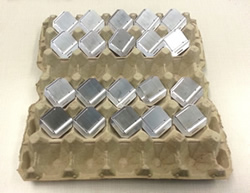
Twenty new wedge range filter (WRF) precision compact proton spectrometers developed at the Massachusetts Institute of Technology have been delivered to NIF. The WRF is one of three diagnostic devices created at MIT that are designed to measure the spectrum and timing of NIF neutrons and protons.
The WRF measures the spectrum of proton energy in the range from four to 20 million electron volts (MeV) using a wedge of filter material placed in front of plastic film. Commonly used on all deuterium and deuterium-helium3-fueled NIF implosions, the WRF proton spectrometers measure the implosion areal density at a time referred to as the "shock flash bang time," which happens about one nanosecond before the main implosion bang time (in ICF experiments, bang time is the time interval between the start of the laser pulse and peak x-ray emission from the fuel core).
The operations and upgrades of the accelerator used to calibrate the WRFs are done by seven PhD students and two postdocs, several of whom are directly involved in the NIF experimental campaigns. The PhD students directly involved in NIF experiments are Mike Rosenberg, Alex Zylstra, Hans Rinderknecht, and Hong Sio.
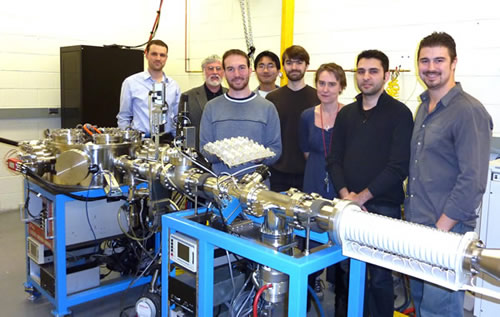
Efforts to Improve NIF Optics Damage Resistance Described
NIF Optics and Targets Science & Technology Manager Tayyab Suratwala discussed NIF & Photon Science's programs to improve laser damage resistance of the facility's optics during high-energy laser operations in an invited presentation at a conference held Jan. 6-11 on the properties and functional energy applications of glass.
Suratwala said that glass material quality (often its surface) limits the energy of many high-peak-power laser systems. During fabrication, post-processing, and laser operation, numerous and complex surface interactions occur that can create, modify, and/or remove surface damage precursors such as microfractures (scratches), chemical impurities, and particulate contamination. These factors can cause localized laser damage via direct absorption and heating or downstream modulation of the incoming laser light.
Suratwala reviewed the science and technology progress and future challenges for understanding these glass surface interactions, the resulting surface precursors, and the methods to mitigate them. He said two process technologies used for NIF – improved grinding and polishing processes to reduce the number of microfractures on the optic's surface and a novel buffered oxide etch process called the Advanced Mitigation Process on fused silica optics – have greatly improved the laser damage resistance of fused silica optics. Combining these more damage-resistant optics with NIF's "Loop" strategy for recycling optics has enabled NIF to operate at higher energy (1.8 megajoules) and power (500 terawatts).
 Rusty Steele works on a new CISR-1 polisher. A new convergent polishing process is being developed for finishing high quality optics more deterministically and at lower cost.
Rusty Steele works on a new CISR-1 polisher. A new convergent polishing process is being developed for finishing high quality optics more deterministically and at lower cost. The future manufacturing challenge, he said, is to create largely scratch-free optical surfaces while reducing finishing cost (the photo shows a polisher being developed to accomplish this). Large opportunities also still exist to improve the surface damage resistance even further. Suratwala said the future challenges of laser damage initiation and growth during laser operations include identifying and mitigating even higher-fluence (energy per unit area) precursors and developing a greater understanding of multi-shot changes and debris-induced effects to glass surfaces during laser shots.
Science on NIF Technical Review Committee Meets
The Science on NIF Technical Review Committee, chaired by former Argonne National Laboratory director and current University of Chicago professor Robert Rosner, met on Jan. 7-8 to review progress and plans for fundamental science on NIF.
In his welcoming remarks, NIF Director Ed Moses said the committee is "an essential element of NIF governance" that plays a "critical role in helping establish a first-rate fundamental science program at NIF." After briefings on NIF's status and experimental path forward, the committee discussed a variety of research under way or planned on NIF, from carbon and iron equations of state to hydrodynamic and radiative shock effects in supernovas.
Committee members attending this meeting were Riccardo Betti of the Laboratory for Laser Energetics at the University of Rochester, Nathaniel Fisch of Princeton University, Richard Firestone of Lawrence Berkeley National Laboratory, Ramon Leeper of Sandia National Laboratories, Christopher McKee of UC Berkeley, Mordy Rosen of LLNL, John Sarrao of Los Alamos National Laboratory, and Choong-Shik Yoo of Washington State University.
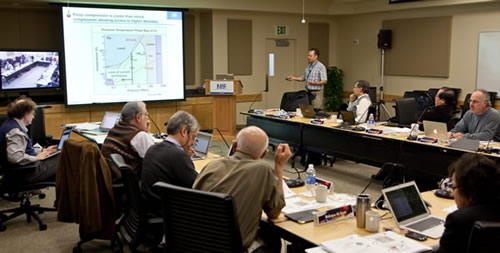 Ray Smith briefs the Science on NIF Technical Review Committee on NIF ramp-compression equation-of-state experiments.
Ray Smith briefs the Science on NIF Technical Review Committee on NIF ramp-compression equation-of-state experiments. Effects of Species Separation in Inertial Confinement Fusion Implosions
New simulations of inertial confinement fusion (ICF) experiments indicate that in the inner gas of an ICF target, ions of deuterium and tritium, the hydrogen isotopes in fusion fuel, may separate as they converge toward the center. The result of this "species separation," according to a Physics of Plasmas paper published online on Jan. 3, could be that deuterium and tritium ions arrive at the target's center at different times, reducing the amount of neutrons produced during the first stage of an ICF implosion.
LLNL researchers and their collaborators used multi-fluid particle-in-cell simulations to show that as the spherical shock wave propagates through the inner gas of an ICF implosion and converges toward the center of the target, deuterium ions (deuterons) may "run ahead" of the tritium ions (tritons) due to their lower mass and higher charge-to-mass ratio, and could reach the center several tens of picoseconds before the tritons. The rising edge of the deuterium and tritium fusion rate may also be temporally separated by the same amount, an effect which should be observable in experiments by measuring the time differential between the deuterium and tritium shock yields.

The researchers said the implications of species separation for current NIF ignition experiments are under investigation. "Since the actual separation between ion species is closely dependent on the correct modeling of the collision physics, fully kinetic (particle-in-cell) simulations of ICF experiments are needed to further investigate the effects of multi-species," they said. "This work suggests the need for adapting mainline ICF simulations to include ion separation and kinetic effects in mixed species fuels."
Lead author Claudio Bellei was joined by LLNL researchers Peter Amendt, Scott Wilks, and Daniel Casey, along with colleagues from the Blackett Laboratory of Imperial College in London, the Plasma Science and Fusion Center at MIT, and Voss Scientific of Albuquerque, NM.
SRS and Speckle Interaction in Multi-speckled Laser Beams
Stimulated Raman scattering (SRS) is a type of laser-plasma instability of concern for laser-driven fusion experiments such as those now under way at NIF. In SRS, electron density fluctuations in the plasma cause the incident laser light to scatter resonantly. High levels of backscatter reduce the coupling of laser energy to the fusion target and place stringent constraints on implosion symmetry and other design parameters.
In a Physics of Plasmas paper published online on Jan. 9, LLNL researchers and collaborators from Los Alamos National Laboratory noted that multiple intensity "hot spots" – regions of locally large, elongated laser intensity known as "speckles" produced by the optics used in NIF – can produce SRS by interacting collectively.
By studying the relationship between speckles and SRS, the researchers found that in a multi-speckled laser beam, intense speckles exhibit nonlinear SRS behavior first and produce both forward and side-loss high-energy ("hot") electrons, which seed and enhance the growth of SRS in neighboring speckles. This collective interaction results in significant SRS at lower average beam intensity than it would otherwise, and SRS backscatter at angles outside that of the incident beam cone, similar to what is observed in experiments.
The researchers said the inclusion of a moderately strong magnetic field in the laser direction can effectively control SRS by suppressing transverse speckle interaction via hot electron transport. While the size of the magnetic field may not be practical in ignition experiments, they said, "this technique allows hot electron coupling effects to be distinguished from light wave coupling in simulations."
Lead author Lin Yin of LANL was joined on the paper by several LANL colleagues and by LLNL's Bob Kirkwood and Pierre Michel.
Moses Reports on NIF&PS Progress and Plans at All-Hands Meetings
NIF Director Ed Moses reviewed the accomplishments of the NIF & Photon Science Directorate in 2012 and described the Directorate's programs, plans and challenges for the New Year in a series of All-Hands meetings on Jan. 16. Describing 2012 as a "spectacular" year for the Directorate, Moses said NIF conducted 180 target physics experiments and another 150 laser shots without targets in fiscal year 2012, and the facility is now undergoing a transition into "the world's preeminent high-energy-density user science facility" for conducting Stockpile Stewardship, fusion energy, national security applications, and fundamental science experiments.
Moses outlined a reorganization and program consolidation now under way with the goal of creating a "stronger, more flexible organization" that will carry NIF&PS into the future. While the fiscal year 2013 Federal budget remains somewhat uncertain because of sequestration and the like, he said, "We have prepared in the best way we can for this situation."
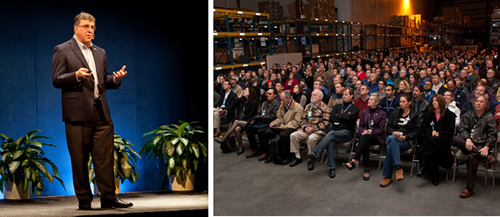 NIF Director Ed Moses addresses a January 16 All-Hands meeting.
NIF Director Ed Moses addresses a January 16 All-Hands meeting. Although challenges remain in achieving the implosion symmetry and pressure needed for ignition, Moses said researchers are now experimenting with different hohlraum configurations in an effort to resolve those issues. Moses noted that the National Ignition Campaign, which concluded at the end of September, made "enormous progress" in developing the NIF ignition platform while building a large national and international family that continues to pursue the "grand challenge of demonstrating fusion ignition and burn via ICF (inertial confinement fusion) on NIF."
Dynamics of High-Energy Proton Beam Acceleration Discussed
Intense, beamlike emissions of greater-than 10 MeV (million electron-volt) protons can be generated from a solid foil target. One application of this technology is the use of laser-driven proton beams to ignite a fast-ignition (FI) target (in fast ignition, a pulse of energy is fired into the center of the compressed fusion fuel to ignite the fusion reaction). The beam can be focused from a relatively large target to a small spot size (tens of microns) with an extremely high energy density. This eases the requirements on laser focus and intensity and permits design for both the optimum particle energy and the requisite particle beam density for FI.
In a Physical Review E paper published on Jan. 25, LLNL researchers and their collaborators reported on studies of acceleration and focusing of high-energy proton beams from FI-related hemisphere-cone assembled targets. The studies used hybrid particle-in-cell simulations to investigate the dynamics of proton-beam acceleration and focusing from planar-foil, open-hemisphere, and hemisphere-cone target geometries by intense laser pulses. The researchers said the results are of great interest for proton fast ignition point design and other applications in high-energy-density physics.
Authors Bin Qiao and Farhat Beg of the Center for Energy Research at UC San Diego were joined by LLNL's Mark Foord, Mike Key, Harry McLean, and Prav Patel, and collaborators from General Atomics in San Diego.
Lab Celebrates Johnny Foster's Contributions to Science and Security
A daylong series of special events on Jan. 24 honored LLNL's fourth director, Johnny Foster, who turned 90 last September. Foster remains active as a consultant on a range of national security issues and continues to advise the Laboratory's senior leadership.
 Johnny Foster addresses the crowd during his 90th birthday celebration.
Johnny Foster addresses the crowd during his 90th birthday celebration. Foster was LLNL Director from 1961-65, when the Laboratory launched a small laser fusion project in its physics organization. The project focused on building more powerful and efficient lasers, exploring basic aspects of light-plasma interactions, and developing high-power, short-pulse lasers. These early efforts led to the development of the 4 pi laser system in the mid-1960s, which had 12 ruby laser beams arranged around a gas-filled target chamber about 20 centimeters in diameter.
A variety of subsequent laser efforts were consolidated in 1972 with the formation of the Laser Program and Y Division (now the NIF & Photon Science Directorate), and LLNL has gone on to construct a succession of record-setting lasers, culminating in the construction and operation of NIF, the world's largest and highest-energy laser system.
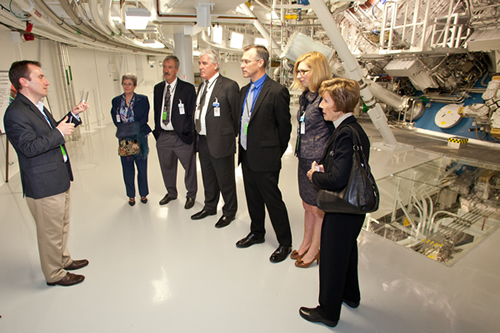 Mike Dunne of NIF&PS (left) briefs members of Johnny Foster's family during their Jan. 24 tour of NIF: (from left) Jean Scott, Scott Foster, Bruce Foster, John Foster, Jr., Kimberly Turner, and Frances Foster.
Mike Dunne of NIF&PS (left) briefs members of Johnny Foster's family during their Jan. 24 tour of NIF: (from left) Jean Scott, Scott Foster, Bruce Foster, John Foster, Jr., Kimberly Turner, and Frances Foster. NIF&PS 'Goes Green' in More Ways Than One
Thanks to the initiative of Facility Point of Contact Barbara Macchioni and the support of Heather Ottaway and Meg Fratanduono of the Lab's Environment, Safety, and Health Directorate, the NIF&PS annual Holiday Potluck and Silent Auction was a "Green Event" in every sense of the term. Not only did the Silent Auction raise about $6,000 to help provide a brighter holiday for 13 families in the Livermore and Tracy areas,  but the use of reusable, recyclable and compostable materials – and their proper disposal in clearly marked containers – kept the amount of waste going to landfills to a minimum.
but the use of reusable, recyclable and compostable materials – and their proper disposal in clearly marked containers – kept the amount of waste going to landfills to a minimum.
LLNL's Green Event Planning Guide notes that the ultimate aim of "going green" is to make our actions sustainable – using less of everything now so that it lasts longer, and choosing to use products, suppliers or procedures that have less of an impact on the planet. "Incorporating sustainable planning into your organization's events," say the guidelines, "ensures that all facets of events management, including location, transportation, food services, energy use, and the provision of materials are approached with the goal of minimizing the negative environmental impacts from conducting the event."
The final Green Event tally showed that NIF&PS participants filled 12 23-gallon bags (276 gallons) with compostable material, two 32-gallon and one 23-gallon bag (87 gallons) with recyclables, and only ¼ of a 32-gallon bag (8 gallons) with garbage. "So, 363 gallons (about 300 pounds) of waste was diverted from the landfill," noted Heather and Meg, "and only 2 percent of the total was garbage. This event happened because Barbara took the initiative," they said; "we were simply there to help back her up. And we would be happy to assist others with similar events."
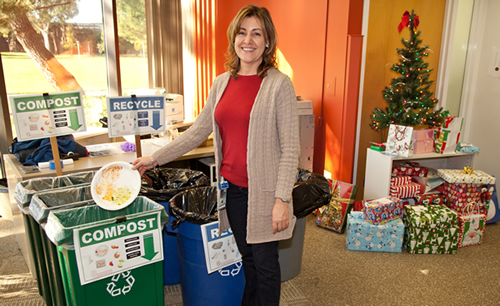 Barbara Macchioni, Facility Point of Contact for Bldgs. 490 and 591, disposes a paper plate in a compost container during the NIF&PS Holiday Potluck and Silent Auction.
Barbara Macchioni, Facility Point of Contact for Bldgs. 490 and 591, disposes a paper plate in a compost container during the NIF&PS Holiday Potluck and Silent Auction. NIF Visitors
Gens. Stoss and Crosier of U.S. STRATCOM Tour NIF
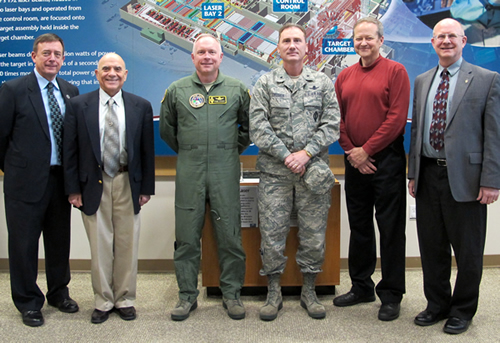 Brig. Gen. Ferdinand B. Stoss III (third from left) and Brig. Gen. Clinton E. Crosier of the U.S. Strategic Command toured NIF on Jan. 9, accompanied by (left to right) Robert Smolen of the Global Security Directorate, Col. George J. Sakaldasis of the LLNL National Security Office, Mike Carter of NIF&PS, and David Rehbein of Global Security.
Brig. Gen. Ferdinand B. Stoss III (third from left) and Brig. Gen. Clinton E. Crosier of the U.S. Strategic Command toured NIF on Jan. 9, accompanied by (left to right) Robert Smolen of the Global Security Directorate, Col. George J. Sakaldasis of the LLNL National Security Office, Mike Carter of NIF&PS, and David Rehbein of Global Security. 


